Galerie H. O. Miethke
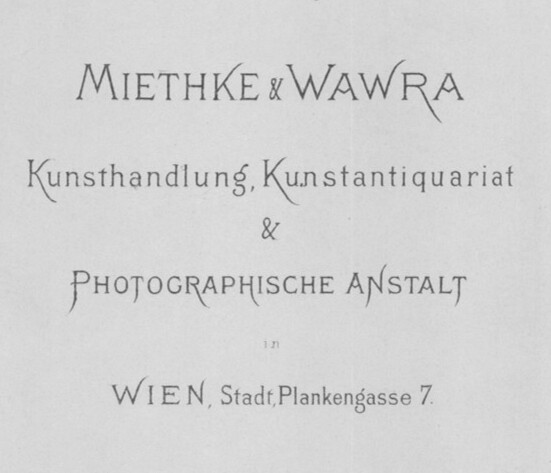
Reverse of a photograph by Miethke & Wawra
© Klimt Foundation, Vienna
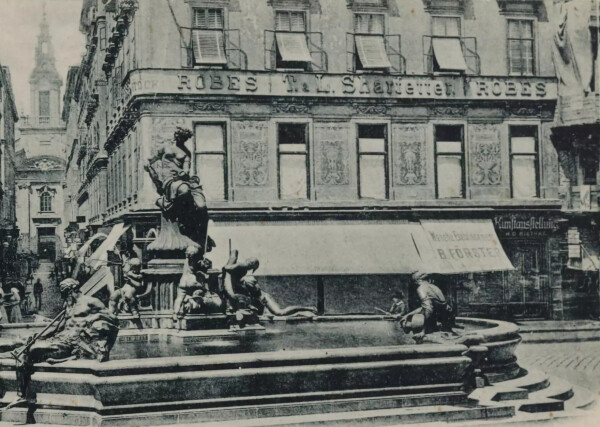
Gallery H. O. Miethke at Neuer Markt 13, corner of Plankengasse 6, before 1896
© Wien Museum
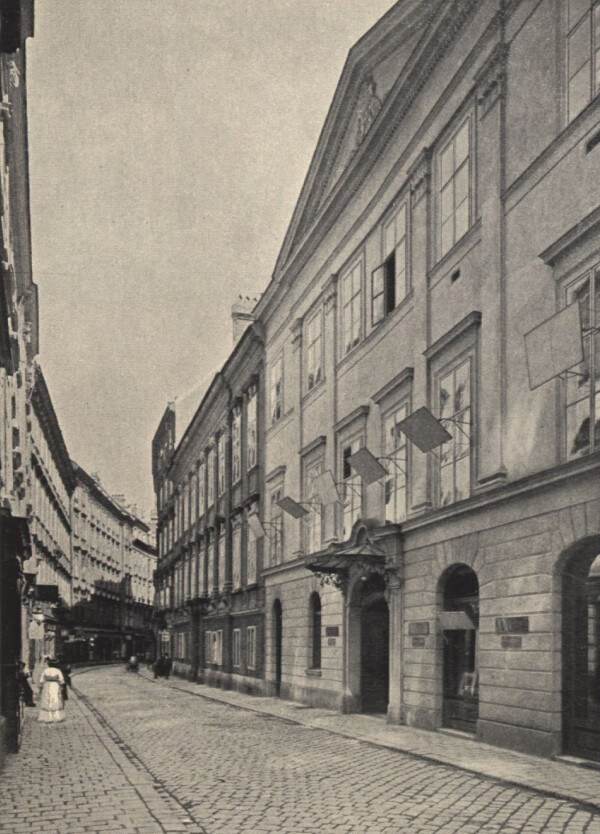
Gallery H. O. Miethke in Palais Nákó, Dorotheergasse 11, around 1906, in: Galerie H. O. Miethke (Hg.): Old and modern pictures. Tableaux anciens et modernes, Ausst.-Kat., Gallery H. O. Miethke (Vienna), 00.07.1906–00.00.1906, Vienna 1906.
© Library of the Belvedere, Vienna
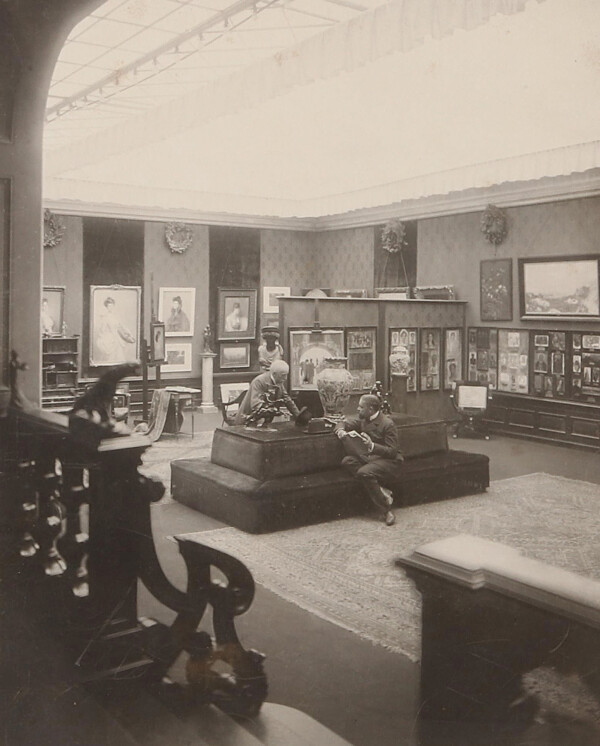
Hugo Miethke in the gallery H. O. Miethke, Dorotheergasse 11, around 1900
© Dorotheum Vienna
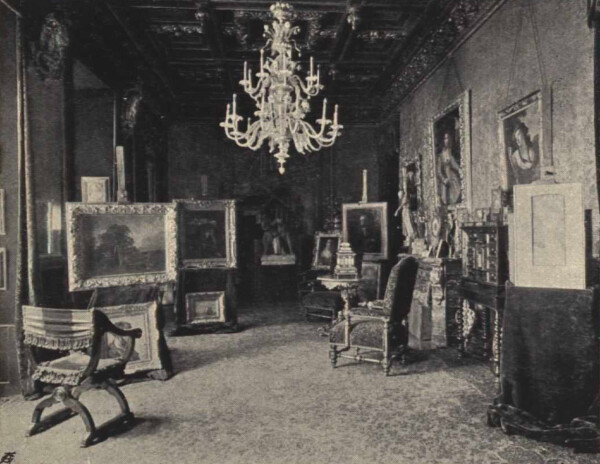
Insight into the Miethke Gallery, undated, in: Galerie H. O. Miethke (Hg.): Old and modern pictures. Tableaux anciens et modernes, Ausst.-Kat., Gallery H. O. Miethke (Vienna), 00.07.1906–00.00.1906, Vienna 1906.
© Klimt Foundation, Vienna
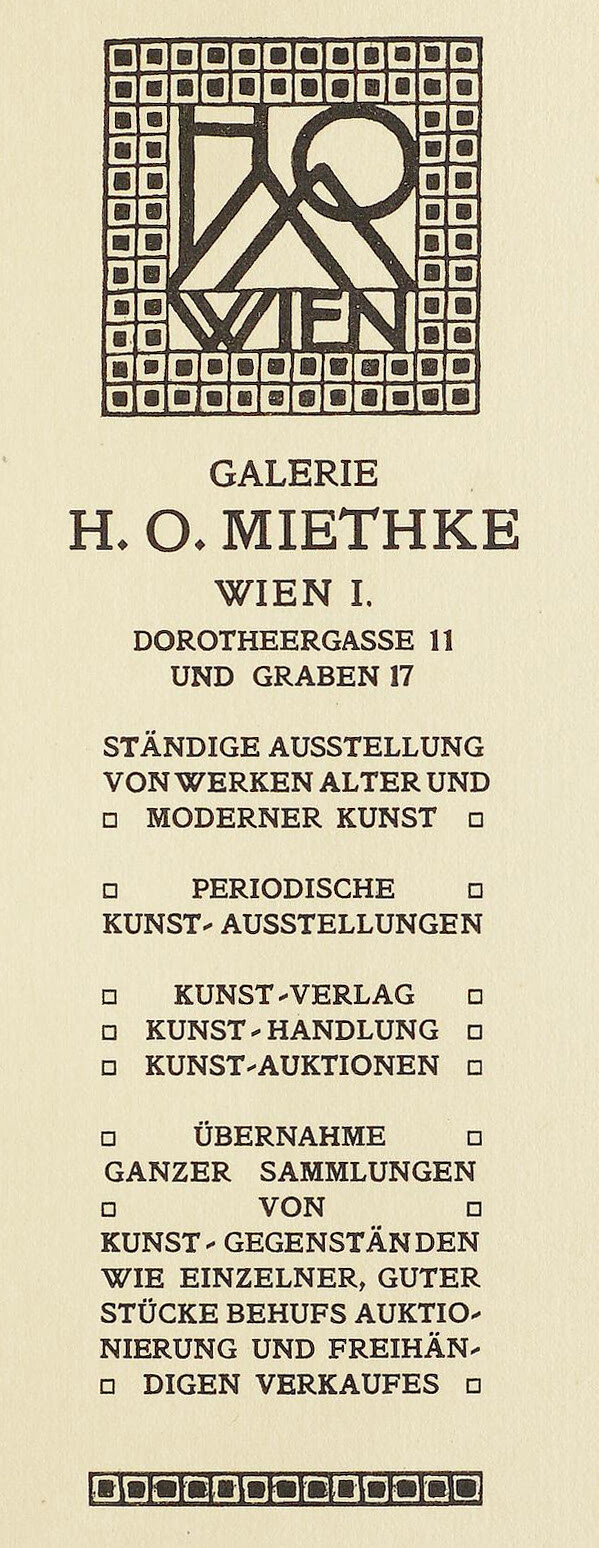
Business advertisement, in: Galerie H. O. Miethke (Hg.): Öffentliche Versteigerung des künstlerischen Nachlasses von Rudolf von Alt in der Galerie H. O. Miethke, Wien, I. Graben 17, Aukt.-Kat., Vienna 1906.
© Heidelberg University Library
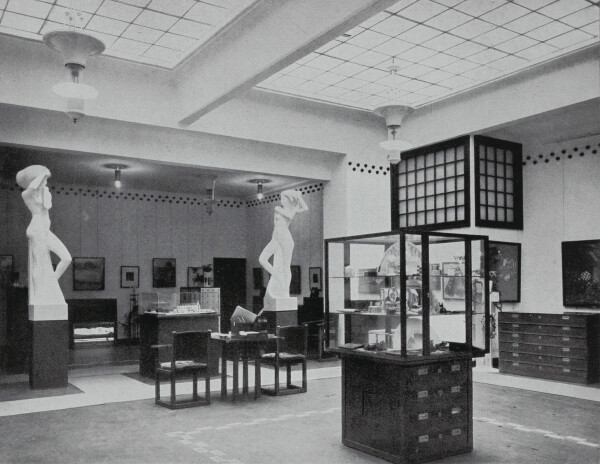
Insight into the gallery H. O. Miethke at Graben 17, 1905, in: Deutsche Kunst und Dekoration, Band 18 (1906).
© Klimt Foundation, Vienna
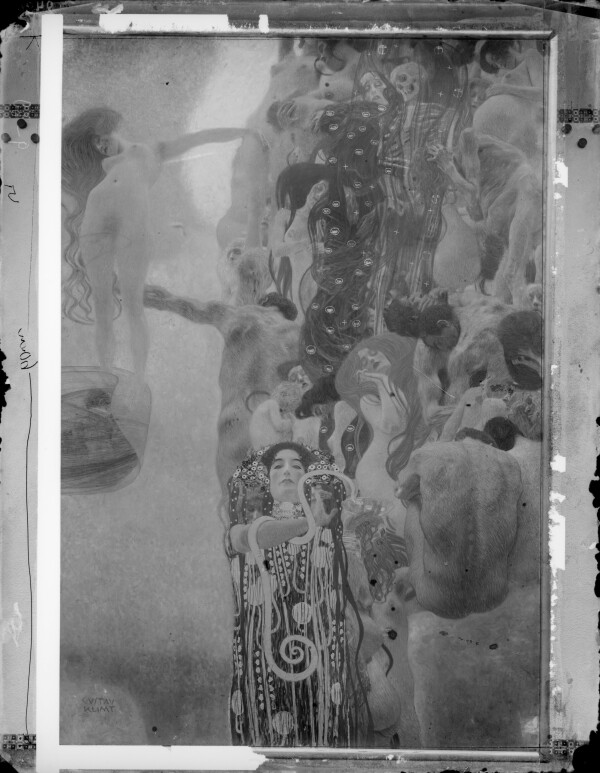
Moriz Nähr: Medicine, presumably circa 1907, Österreichische Nationalbibliothek, Bildarchiv und Grafiksammlung, from the estate of Moriz Nähr
© Picture Archives and Graphics Department, Austrian National Library
Galerie Miethke developed into one of the most prominent art galleries in Austria-Hungary and after the turn of the century operated above all as a groundbreaking center of Austrian and European modernism with its exhibitions.
Carl Josef Wawra was apprenticed to his father, the painter and art dealer Josef Eduard Wawra, and also learned his trade in a number of antiquarian bookstores in Vienna. Together with Hugo Othmar Miethke, who came from Potsdam, he founded the company Miethke & Wawra as a general partnership on 15 October 1861. The two equal partners’ company was entered in Vienna’s Commercial Register in the category of book and antiquarian book trade in 1863. Initially run as an antiquarian bookstore and art publisher with a shop at Singerstraße 30 and a “Photographic-Artistic Institution” at Landstraßer Hauptstraße 95, the company edited photographs, reproductions, and printed works. In the 1860s, Miethke & Wawra rapidly developed into organizers of art auctions in Vienna, with the generally flourishing art trade in the metropolis on the Danube having a favorable influence on the continuous rise of Miethke & Wawra from auction house to gallery. The two entrepreneurs also established international contacts with such important art dealers as Ambroise Vollard, Paul Durand-Ruel, and Charles Sedelmayer in Paris and Paul Cassirer in Berlin. During the 1873 World’s Fair in Vienna’s Prater, Miethke & Wawra managed to rent exhibition rooms at the Künstlerhaus and present the monumental painting Venice Pays Homage to Katharina Cornaro (1872/73, Belvedere, Vienna), which had been commissioned from Hans Makart, in a most spectacular setting. In the subsequent year, however, the two art dealers went separate ways.
Founding of Galerie H. O. Miethke
In early 1874, Hugo Othmar Miethke established Galerie H. O. Miethke, with its headquarters located at Neuer Markt 13/corner of Plankengasse 6, and specialized in the “publication of and trade with painting.” He dealt with old masters, auctioned the estates of artists like Hans Makart, Emil Jakob Schindler, and Rudolf von Alt, and temporarily revived his collaboration with Carl Josef Wawra, whose focus was on graphic art and prints. When it came to the trade in old masters, his clients included not only public collections and museums, but also such renowned private collectors as Gustav Figdor and Count Johann Pálffy. Moreover, Miethke intensified the gallery’s representation of contemporary artists.
In 1895 he purchased the palace of the aristocratic family Nákó at Dorotheergasse 11 (now Palais Eskeles), which he had rebuilt in the style of Neo-Classicism. The first floor accommodated the publishing company and a light-flooded exhibition room for contemporary art featuring a white marble floor and a glass ceiling. The second floor remained largely unchanged, and with its decorated and gilded wooden ceilings provided an ideal ambience for the presentation of old master paintings. On the third floor, the gallery owner installed his private apartment. Once the new facilities had opened on 29 May 1896, the place developed into one of the monarchy’s most important art galleries, presenting old and modern art, as well as Austrian and international art, side by side.
Change of Owners at Galerie H. O. Miethke
As Hugo Othmar Miethke wished to resign from business in his old age, he had undertaken preparations to sell the gallery to the art dealer and “passionate art lover” Hans Weidenbusch from Wiesbaden around 1900. He thought of “not only exhibiting old master paintings as before, but also of cultivating the modern direction to the widest possible degree.” According to the Commercial Register, the sale to Weidenbusch did not take place before 31 May 1904, yet the buyer died unexpectedly soon afterwards.
On 22 November 1904, Paul Bacher took over the gallery as the new owner. He was a jeweler and since 1894 had been married to Emma Paulick, the daughter of the renowned cabinetmaker Friedrich Georg Paulick, a purveyor to the court and friend of Gustav Klimt. Bacher engaged Carl Moll as artistic director of the gallery, “whose administrative talent, skillful mise en scène, and spirited eloquence prove benefits for the company that cannot be appreciated highly enough,” as Adalbert Seligmann acknowledged in the Neue Freie Presse. Moll’s role at Galerie Miethke and the idea that Secession members could also present their art there led to disagreements with the Vienna Secession, aggravating existing conflicts within the association. The so-called “Moll Affair,” ended in 1905 with his leaving the Secession, which was heated up in the media, as both sides voiced their statements in the daily newspapers and art magazines. The Association of Austrian Artists Secession argued that Moll’s position at Galerie Miethke and his subsequent resignation were the cause for the resignation of the so-called “Klimt Group” shortly afterwards. However, according to Moll, the members around Klimt resigned “many weeks later and for fundamentally different, purely artistic reasons.” Moreover, he stated in Die Werkstatt der Kunst:
“The colleagues Klimt, Prof. Hoffmann, and Prof. Moser appointed me to assist Mister Bacher as artistic advisor during the first years, and thus I was put in charge of Galerie Miethke’s exhibition activities entirely independently of the art dealership operated by Mr. Bacher.”
Moll initiated the modernization of the exhibition facilities in Dorotheergasse, which may have been light-suffused thanks to the skylight, but were decorated with dark wall paneling and fabric wall covering. The redesign into a puristic space with white plasterwork, black window and door frames, and a frieze of black iron knobs for hanging up the pictures had been conceived by Kolo Moser, who also designed a new company logotype. Using the characteristic iron knobs, Moser, together with Josef Hoffmann, also decorated in a similar fashion the room of the new exhibition venue that had opened at Graben 17 in December 1905 with a show of the Wiener Werkstätte. With its innovative corporate design, the neutral exhibition rooms in form of a white cube, and its avant-garde program, Galerie Miethke had now become the Secession’s immediate rival.
By the agency of Adolf Hölzel, art theorist and journalist Arthur Roessler was appointed “business director,” but handed in his resignation after hardly a year. In July 1906, Roessler was succeeded by Emil Maria Steininger, the long-time secretary of the Vienna Kunstgewerbeverein, who also gave up his position as director after one year.
Hugo Haberfeld’s Role at Galerie H. O. Miethke
As Paul Bacher died on 5 May 1907, his widow, Emma Bacher, became the gallery’s new owner. Shortly before, art historian Dr. Hugo Haberfeld had taken over the position of director. He worked as an art critic for such periodicals as Die Zeit and Kunst und Künstler and by that time had written several prefaces for the gallery’s exhibition catalogs. Haberfeld was one of the earliest clients of Adolf Loos, who around 1902 had designed the interior of the former’s apartment, and became one of the leading figures of the gallery. In early 1907, he successfully established himself as artistic director next to Moll, but soon tensions and rivalries made themselves felt between them. And as Emma Bacher wished to invest less capital in the acquisition of old masters, Moll, giving her an ultimatum, urged her to decide between Haberfeld and him, and then finally left the gallery in July 1912.
Haberfeld, now the sole director, introduced the format of presentations of private collections, including those of Ludwig Hevesi and Richard Muther. He traded old masters and contemporary art simultaneously, including that of young painters like Egon Schiele, to whom the gallery dedicated a solo exhibition in 1911, former Secessionists, and the artists of the Wiener Werkstätte, as well as pioneering exponents of European modernism like Aubrey Beardsley, Claude Monet, Édouard Manet, Paul Gauguin, Vincent van Gogh, and Pablo Picasso. Between 1913 and 1914, the gallery was in charge of the Municipal Art Gallery in Karlovy Vary in Bohemia, organizing an exhibition in collaboration with the Parisian art dealer Bernheim-Jeune.
Galerie H. O. Miethke as Gustav Klimt’s Agency
Starting in 1905 and following his resignation from the Secession, Gustav Klimt evolved into the figurehead of Galerie H. O. Miethke, which represented the artist and managed his participations in exhibitions, public relations work, and sales, edited several consignments of the portfolio The Work of Gustav Klimt, and issued permits for the reproduction of Klimt’s works. Klimt’s solo exhibition, where he showed the three controversial Faculty Paintings of Jurisprudence (1903–1907, destroyed by fire at Immendorf Castle in 1945), Medicine (1900–1907, destroyed by fire at Immendorf Castle in 1945), and Philosophy (1900–1907, destroyed by fire at Immendorf Castle in 1945) for the first time in Austria as a group of three finalized works, caused quite a stir. In the context of the “Kunstschau Wien 1908” and the “Internationale Kunstschau Wien 1909,” the gallery administered organizational tasks on behalf of Klimt in his function as president of the exhibition committee, as all inquiries were to be directed to the gallery. 81 surviving file cards document sales of the artist’s works, with such names as Ast, Bloch-Bauer, Waerndorfer, Zuckerkandl, and Wittgenstein.
In 1915, the company moved to Augustinerstraße 6, and in 1917 Emma Bacher, who had married Richard Teschner in 1911 and had since then been named Emma Teschner, sold the company to Hugo Haberfeld. After the outbreak of World War I, he could not continue his previous successes and, being Jewish, was forced to flee to France with his family during the NS regime. The gallery was finally deleted from the Commercial Register in 1940.
Literature and sources
- Österreichisches Biographisches Lexikon. Carl Josef Wawra. www.biographien.ac.at/oebl/oebl_W/Wawra_Carl-Josef_1839_1905.xml (08/26/2020).
- Tobias G. Natter (Hg.): Die Galerie Miethke. Eine Kunsthandlung im Zentrum der Moderne, Ausst.-Kat., Jewish Museum Vienna (Vienna), 19.11.2003–08.02.2004, Vienna 2003.
- Berta Zuckerkandl: Aus dem Leben eines berühmten Kunsthändlers. Interview mit Herrn Miethke, in: Wiener Allgemeine Zeitung, 29.01.1905, S. 3-5.
- -n-.: Kunstsalon H. O. Miethke, in: Neue Freie Presse, 30.05.1896, S. 7.
- --nn.: Die Galerie Miethke in Wien, in: Kunstchronik. Wochenschrift für Kunst und Kunstgewerbe, N.F., 7. Jg., Heft 31 (1895/96), Spalte 503-507.
- V.: Karl Josef Wawra, in: Oesterreichisch-ungarische Buchhändler-Correspondenz, 46. Jg., Nummer 23 (1905), S. 333.
- N.N.: Verkauf des Kunstverlages H. O. Miethke, in: Neue Freie Presse, 28.12.1899, S. 6.
- Josef August Lux: Moderne Kunstausstellung, in: Arbeiter-Zeitung, 13.12.1905, S. 1-2.
- Adalbert Franz Seligmann: Waldmüller-Ausstellung, in: Neue Freie Presse, 20.11.1904, S. 12-13.
- N. N.: Die Spaltung in der Wiener Sezession, in: Die Werkstatt der Kunst. Organ für die Interessen der bildenden Künstler, 4. Jg., Heft 39 (1905), S. 530-531.
- Horst-Herbert Kossatz: Der Austritt der Klimt-Gruppe. Eine Pressenachschau, in: Alte und moderne Kunst. Österreichische Zeitschrift für Kunst, Kunsthandwerk und Wohnkultur, 20. Jg., Heft 141 (1975), S. 23-26.
- Berta Zuckerkandl: Ein Haus für die Künstlerschaft, in: Wiener Allgemeine Zeitung, 23.04.1919, S. 3.
- Christian Huemer: Carl Moll als Ausstellungsmacher und Kunsthändler, in: Cornelia Cabuk, Christian Huemer, Stella Rollig (Hg.): Carl Moll. Monografie und Werkverzeichnis, Vienna 2020, S. 70-91.
- N. N.: Ein neuer Kunstsalon, in: Die Zeit, 03.12.1905, S. 3-4.
- A. F. S.: Zweckkunst, in: Neue Freie Presse, 07.12.1905, S. 1-3.
- N. N.: Kunstschau 1908, in: Neue Freie Presse, 11.03.1908, S. 12.
- N. N.: Galerie Miethke, in: Die Zeit, 03.05.1907, S. 3.
- Ansichtskarte von Carl Moll in Madrid an Emma Bacher in Wien, mitunterschrieben von Gustav Klimt, LGM 31/13 (30.10.1909), .
- Ansichtskarte von Gustav Klimt in Wien an Emilie Flöge in Bad Gastein, 1. Karte (Morgen) (29.06.1912). RL 2865, .
- Wiener Stadt- und Landesarchiv. Handelsregister Ges 4/106, Signatur 2.3.3.B75.4.106, Miethke & Wawra. www.wien.gv.at/actaproweb2/benutzung/archive.xhtml (11/17/2022).
- Brief von Carl Moll an Ludwig Abels (vermutlich um den 17.10.1930). Autogr. 1530/24-1, .
- Neues Wiener Tagblatt (Abendausgabe), 02.10.1912, S. 5.

